How to Make a High-MERV DIY Portable Air Cleaner
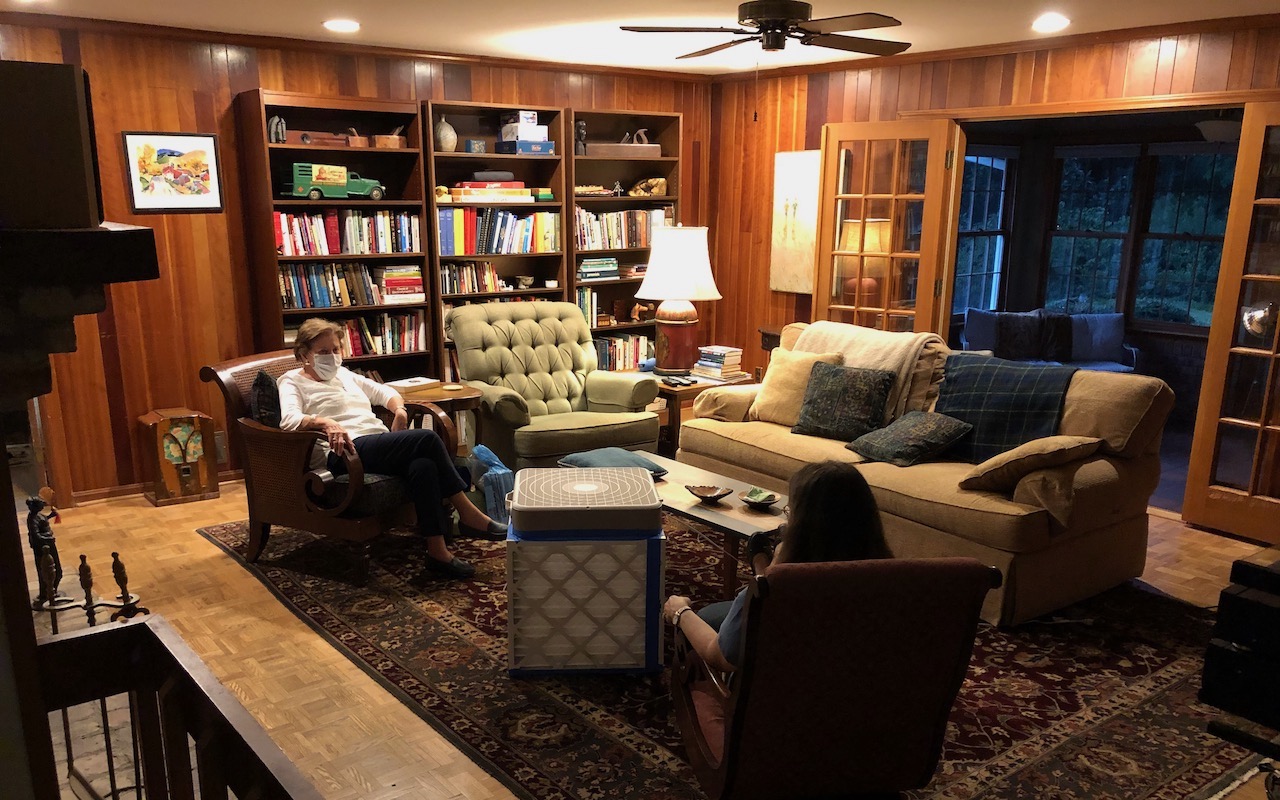
Twitter is an utter hellscape in some ways, but it does have a few redeeming qualities. I’ve seen a lot of good information about the COVID-19 pandemic there, including ways to filter the indoor air for coronavirus and the emerging science about the spread of SARS-COV-2 via aerosols in addition to droplets. On the filtration front, one thing I started seeing there over the past few months was designs for portable air cleaners you could make with a box fan. Of course, the easiest way to do it is just tape one filter to the back of the fan. To reduce the pressure drop, though, you can attach two or more filters to the fan, and Shawna Henderson of Blue House Energy in Nova Scotia discussed the ones I’ve seen in this nice article: 3 Principles for Good IAQ: Eliminate, Ventilate, & Filtrate.
The one with four filters is the one I like best, so I made a couple of them, one for my home and one for the Energy Vanguard office. John Semmelhack sent out the tweet below last month of this four-filter design by Neil Comparetto, a top-notch home performance contractor in Virginia.
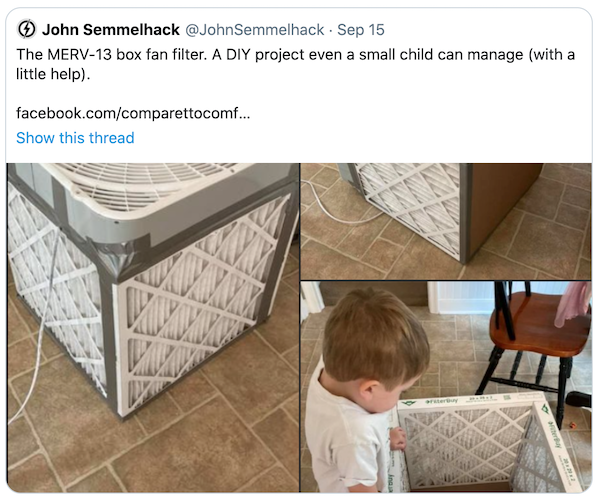
It’s a modification of a design that I think Dr. Richard Corsi (of Corsi Code fame) promoted. Corsi’s version uses five filters, which means you have to have a base or some other way to support it (or else have one filter that doesn’t get any air). Comparetto used four filters, with the bottom side covered by cardboard. Since it has six equal sides, we can call it the Comparetto Cube.
The cardboard base allows it to sit on the floor without any other support. It also blows the air straight upward, and that makes it ideal for when you have company in your home. Just set the Comparetto Cube in the middle of the room, and if anyone does happen to be sick, a lot of the droplets and aerosols should get pulled into the fan and filtered out. The photo at the top of this article shows it in use at my house on a recent visit by my mother-in-law.
How to make a Comparetto Cube
I probably don’t need to give any instructions here because it should be obvious what to do, but here you go. First, get the materials you need. I ordered the 20″ box fan and 20″ x 20″ MERV-13 filters* from Amazon for a total cost of $90.82. The box fan (Comfort Zone CZ200A)* was $25.20, the filters (FilterBuy) $65.62. Once you have those, the only other things you need are tape and scissors or a box cutter. I used the box the fan came in for the piece of cardboard that goes on the bottom.
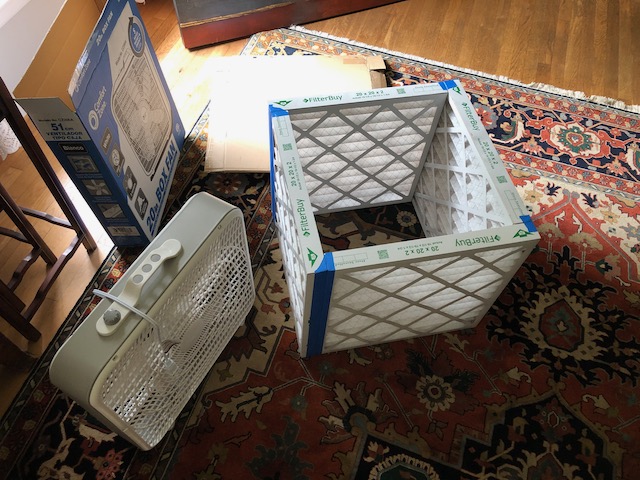
The first step is to tape the filters together. I used little pieces of tape at the corners to hold them together first and then covered the seams with long strips. Then I went back and double-taped the corners for a little extra reinforcement.
Two notes: First, make sure you tape the filters together with the arrows pointing into the center of the square. The fan will sit on top, pulling air in through the filters and sending it up and out through the top. Second, arrange the filters in a square, as you see below, not a rectangle.
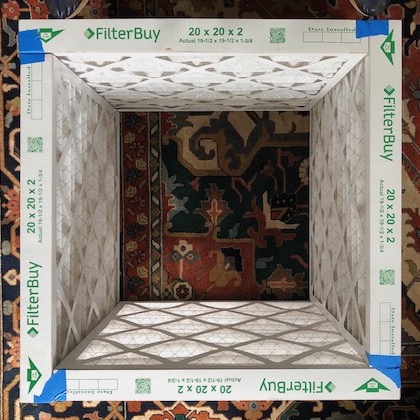
Next, cut a piece of cardboard the size of the filter square and tape it to one end. Energy Vanguard’s Luke Bertram is taping the cardboard bottom onto the filters in the photo below.
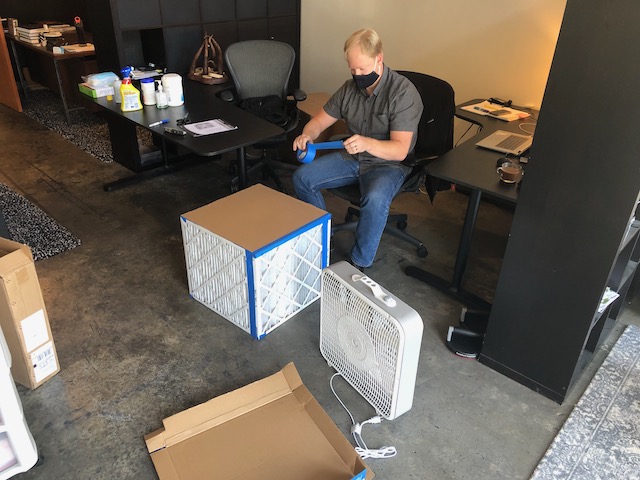
Finally, turn the filters over and tape the box fan to the other end. I used blue painters’ tape, but you can use duct tape if you’d like. (Just don’t use duct tape on ducts!)
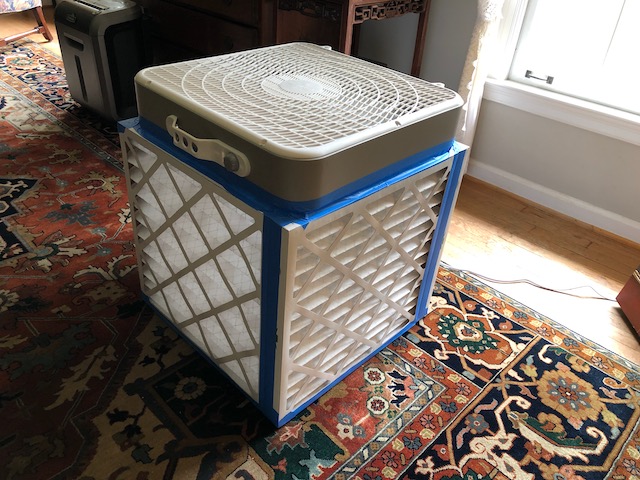
How to stay safe from COVID-19 in your home
The number one thing you can do to prevent the spread of COVID-19 in your own home is not to have other people in it. My wife and I have done that since the middle of March now, with only a few exceptions. We’ve had a few people come into our house, though, and we’ve worn masks, run the ventilation more, and opened windows when the weather is nice enough. And now that we have a Comparetto Cube, we run it whenever others are in the house (with masks on) and for a while afterward. As mentioned earlier, keeping the portable air cleaner in the middle of the room should greatly reduce the risk of transmission, if someone happens to be infected.
Filtration, whether with a Comparetto Cube, masks, or HVAC filters, isn’t the whole answer, of course. Social distancing and ventilation are also really important. Now that we have nice fall weather in Atlanta, we occasionally have people over in the backyard, spaced about 10 feet apart.
So yeah, Twitter is a hellscape. But in addition to the good building science community there, I’ve found other gems. Paul Bronks (@SlenderSherbet) puts the best captions on animal videos. The Auschwitz Memorial account (@AuschwitzMuseum) provides sobering reminders of how bad things can get when we lose sight of the humanity of others. Stewart Brand (@stewartbrand) of Whole Earth Catalog fame puts out some of the most intelligent social media posts anywhere. From him I discovered the novel Stoner by John Williams.* That tip alone was worth all the pain.
Who knows? Maybe you found this article on Twitter and have built your own Comparetto Cube. Maybe you even use it when you’re reading Stoner.
Allison Bailes of Atlanta, Georgia, is a speaker, writer, building science consultant, and founder of Energy Vanguard. He is also the author of the Energy Vanguard Blog. You can follow him on Twitter at @EnergyVanguard.
Related Articles
What Percent of Time Do You Spend Indoors?
Can Your HVAC System Filter Out Coronavirus?
Which Indoor Air Pollutants Matter Most?
* These are Amazon Associate links. You pay the same price you would pay normally, but Energy Vanguard makes a small commission if you buy after using the link.
NOTE: Comments are moderated. Your comment will not appear below until approved.
This Post Has 21 Comments
Comments are closed.

Now I have to wonder, since
Now I have to wonder, since you are highly qualified to answer these questions:
Did you measure pressure drop across the filters? Do you have a CFM estimate for the fan on high speed?
The main reason I am wondering is because I come across standalone HEPA towers for less than $100 and I want to compare cost vs. air filtration rate.
Bobby, that’s a great
Bobby, that’s a great question. No, I haven’t measured those things yet, but John Semmelhack just did and will be releasing his results soon. And he did for different configurations. Stay tuned.
Allison, Why not take these
Allison, Why not take these MERV 13’s to near HEPA. All you need is four negative ion generators, placing each one in front of the filter inlets. The agglomeration produced will dramatically improve your filter efficiency. AND according to some folks, it might even improve your marriage. Just don’t set them near a wall…..
Danny, interesting thought. My first thought was that the filter fibers become electrostatically charged from the air flow. Any thoughts or references to read on how much adding the negative ions adds over the expected charge of the fibers from the airflow?
I actually built one of these
I actually built one of these recently! All total, it cost me around $70 to make. One thing that I ran into was most of the air being pulled in through the open corners of the box fan as well as some through the filters. I blocked off the corners of the box fan with strips of duct tape and it really helped mitigate that.
Other than reducing the area for air to bypass the filters, do you have any suggestions for dealing with this issue?
Question: Would it not be
Question: Would it not be better to suck the air into the fan or place the fan pointing down and put this up on legs? My thought being laminar air flow. If droplets were headed down anyway and if people are above the fan if the fan is blowing up and mixing the droplets and atomized cov 2 and shooting it up to the ceiling to be distributed through out the room. Would it not be better to suck it in?
Great idea. After seeing the upward facing design showcased on Ask This Old House (credit to Neil Comparetto) I decided to build a horizontally blowing design still with the cardboard on the bottom. With your floor facing mod, instead of using cardboard add a fifth filter. The standoff legs could be just about anything. Thanks John Johnson. Great idea.
How often do you need to
How often do you need to replace the filters? I’m thinking this would be great for a classroom…..
Years ago, saw a write up a
Years ago, saw a write up a box fan with a single one inch filter – same concept, just (1) not horizontal, and (2) using 1/4 the filters. Use it in the garage or basement when doing project and it works well (anecdotally).
Would vertical improve the operation?
Is there an optimal # of filters for an average box fan?
Thanks
What is the area /volume this
What is the area /volume this would cover?
Stoner Magazine? For Geology
Stoner Magazine? For Geology Majors? 😉
For the filters to work effectively, you don’t want too high an airspeed moving through them, more filters means lower airspeed but also, not too powerful a fan.
You’d have to explain why too big of a fan would be ineffective. I’ve built dozens of systems for filtering smell. The more times your air turns over the faster it clears the air. Though I will admit getting it all on the first pass isn’t a significant issue in this case since the rooms air will be filtered a dozen times an hour in some cases.
In this application, you certainly aren’t sucking droplets of spit through the filter and with a appropriate filter even bacteria and germs will not go through the filter. The size of the holes in the filter material don’t change just because you run the air faster through it. If a mask stops the virus in any meaningful way, this will do the same.
One final thing, these fans are not great. You can buy an inline duct fan for $20-60 on amazon that are much stronger and quiter. I am personally building one using 4 20×30 filters and a $100 carbon filter/duct fan combo. These are made to run 24/7 long term. The carbon filter, when inside the ac filters should last for years since the air will already be clean when it hits it.
In my world, in semiconductor research, air exchange is a primary variable. Nowhere, so far, this important variable is not a prime variable in designing and fabricating DIY air exchange design . Nowhere in the DIY for box fan filters air exchange is identified as variable. We use particle detectors and velometers to monitor the air in the laboratory. Hope this is a start of discussion. DIY projects might find a way to measure filtrate and air exchange.
I’ve built 3 of these to be used by our local Health Dept at their vaccination events for +75 year olds. The room that is being used has hydronic heat and ineffective natural ventilation. I was shooting for a turn-over rate of 4 to 6 ACH based on the advertised CFM of the box fans (typically 1800 CFM). As a double check I took one of the boxes out to a HVAC contractor to test using an ALNOR Balometer air flow hood. The results were 280 CFM with the fans installed and 300 CFM in free air. I contacted Lasko and based on that, ordered the Air Flex FF305 which has a 1″ MERV8 filter attached which they say produced 2000/1600 CFM. They said the motor could handle some pressure drop from filters. Back at the shop, it tested worse than the first fan. By the way, the static pressure of the fan box with the fan running on high was .04ICW. The HVAC tech double checked the ALNOR on a room register. Any ideas on whether our readings are off, or whether the manufacturer’s claims are bogus?
Jim, you can’t simply put an Alnor flow hood on the fan to measure its air flow rate. As with the Heisenberg Principle for subatomic particles, the measurement interferes with what you’re trying to measure. You need a different setup. See this Twitter thread from John Semmelhack to find out what they did. With no filters, they measured 1,025 cfm on low speed with a Lasko fan. They 575 cfm on low speed for the Comparetto Cube.
I’ve been chatting with the Lasko rep. She is claiming that lying the fan horizontally dramatically changes the output of the fan. In my case, reducing the air flow from 2000 cfm to less than 300 cfm. I’m very skeptical. Does anyone have any ideas?
If you direct the fan down shouldn’t you point the arrows to the outside of the box?
This fan seems very focused on cleaning the air of germ and virus droplets. How would it perform in a smokey situation? With all the fires all around the west, people would appreciate a way to keep their air moderately smoke free.
Kathleen, yes, this DIY portable air cleaner is great for smoke and many people are using them for that, too. High-MERV filters remove lots of particulates from the air. It doesn’t matter whether they’re virus-carrying aerosols or tiny bits of ash from fires.
Great how-to, Allison. Thank you.
1. I was wondering about the question Jim Baerg posed about the efficacy of the fan in a horizontal position. Thoughts?
2. Intrigued by your recommendation about Paul Bronks’ Twitter posts (@SlenderSherbet), I checked out his page and found, alas, that his account had been cancelled. Nuts.